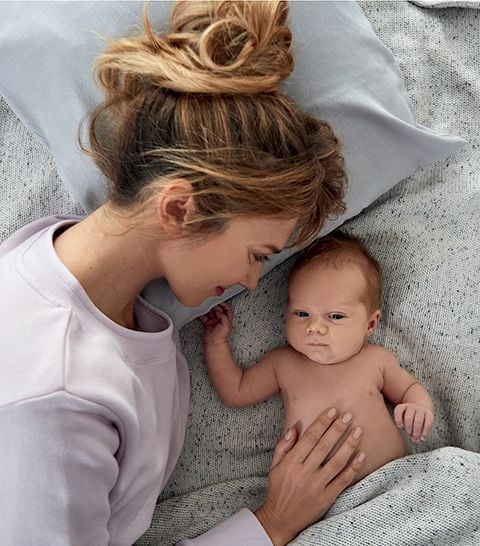
How do babies learn to crawl?
3 to 6 months
Starting around three months old, you may notice your baby do a “mini pushup” while on their stomach, using their arms as support they would lift their head and shoulders high. This will help strengthen the muscles used to roll over and crawl. Soon after, they will learn to roll over from their tummy to their back.
5 to 6 months
Around five to six months of age, your baby will be able to roll from their back to tummy and sit up with some help from you. They are most likely to love this experience as it gives them a new perspective. However, it is important to stay close and supervise when seated as they would be still wobbly at this point.
7 to 8 months
At the eight months mark, your baby will be able to sit on their own and start getting on their hands and knees from a sitting position. Now, they’ll be strong enough to hold their own head while looking around and maintaining a good balance to start the next big milestone i.e., crawling.
9 to 10 months
Once they are able to transition from a sitting position to all fours confidently around nine or ten months of age, they’ll soon start to push off with their knees to crawl. After this, the more they practise, the better they’ll get. Crawling will not only develop your baby’s fine motor skills but also improve their spatial skills and build self-confidence.

How can you teach your baby to crawl?
Whether your little one is showing signs of crawling or if they are a late bloomer, below are few ways you can support them on their journey:
Put them on the floor
Regular supervised tummy time will help your baby practise raising herself on all fours to help build strength in her back, neck and arms. Make sure they get at least 30 minutes of tummy time every day to better prepare them for crawling.
Prop them up to sit
Most babies easily transition from sitting to crawling. Assisted at first and unassisted later on, sitting will help your baby develop strong abdominal and back muscles for crawling. One day, while they are on their bum, they might lean over and discover that they can prop their body on their hands and legs. From here, your little one may start holding themselves in a plank pose or start rocking back and forth until they figure out how to move forward.
Encourage them to play with their hands elevated
Helping your baby learn how to crawl is all about building all the muscles involved. One way you can do this is to have them play with their hands elevated. Put them on top of a soft pillow during the daily tummy time so that their hands remain in the air. However, it is important to supervise your baby at all times while doing so.
Let them play in front of the mirror
Babies are naturally curious about their environment and are always exploring it to learn new things. Use this to your advantage by placing them in front of a mirror. This will not only spark joy in them but also lead to them trying to investigate their own reflection. You will soon notice that they will start to hold themselves up and reach out towards the mirror. Once again, helping to develop their muscles.
Use toys to encourage crawling
One of the greatest motivators for people is a reward at the end of all their hard work and it is the same for babies. With the right incentive such as their favourite toy or a brand new one placed just out of their reach during tummy time will give them a reason to work their muscles.
Activities like playing tunnel is another fun way to encourage crawling. Remember, this doesn’t have to be too fancy. Simply put a blanket over a couple of kitchen chairs to create a safe and inviting space for your little one to practise their newfound mobility.

Can babies skip crawling?
Yes, some babies skip the crawling stage and directly move on to walking. This is totally natural as every kid is on their own journey towards exploring their surroundings and learning from them. As a parent, you may worry about your little one’s growth and if your child is not showing any interest in crawling, can’t move their arms and legs together in a coordinated motion or hasn’t learned to use both arms and legs equally by the one year mark, we recommend visiting the paediatrician to check for developmental delays.








